
Mortellaro's Nursery
Shrubs, trees, ground covers, native plants, and seasonal color
Wholesale Only
Click on any of the alpha indexes below to view the corresponding lists of plants.
The default list is displayed alphabetically by common name for all plant types. You can view the plants by clicking on the Scientific Name or limit the plant type by using the drop down.
Plants actively being grown for the current season are shown -- selecting Discontinued Items will show plants we have offered in the past.
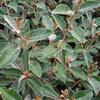
|
Elaeagnus or SilverberyBotanical Name: Elaeagnus pungens
This Chinese / Japanese native shrub can be found in the in some of the most unfruitful places due to its tough and durable nature to grow just about anywhere in Texas. This evergreen shrub sends out pointed branch stems from the base, often several feet before branching off or putting out new leaves. Leaves are oval shaped, up to four inches long and slightly wavy. They are green on top with brown scales, and lighter green with silver flecks on the bottom. They are not smooth to the touch, and hardly plain to look at. Bell shaped flowers in the fall are barely noticeable by sight, but easily acknowledged by the strong scent. The flowers turn to berries shortly after, and are food for birds early into the winter. Elaeagnus can be a nice, tightly trimmed hedge with a uniform shape, but will require constant pruning of the branches that emerge. It will grow in any soil condition except poorly drained soils, and tolerates heat and drought nearly like no other shrub. [ More Info ]
|
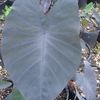
|
Elephant EarBotanical Name: Colocasia esculenta 'Black Magic'
Fast growing herbaceous perennial with heart-shaped leaves reaching up to 2-3 feet in length and 1-2 feet in width. Grows fine in standing water or poorly drained soils; responds very well to regular fertilization. Requires more water if grown in full sun. A gorgeous ornamental with many cultivars available on the market. 'Black Magic' cultivar has purplish-black leaves that turn a dullish green in the heat of the summer. Colocasia dies back in colder climates and will return if the corms do not dry out. [ More Info ]
|
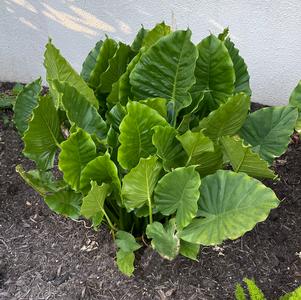
|
Elephant EarBotanical Name: Alocasia sp.
Fast growing herbaceous perennial with large heart-shaped leaves reaching up to 3-6 feet in length and 3-6 feet in width. Grows fine in standing water or poorly drained soils; responds very well to regular fertilization. Requires more water if grown in full sun. A gorgeous ornamental with many cultivars available on the market. Colocasia dies back in colder climates and will return if the corms do not dry out. [ More Info ]
|
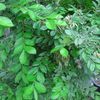
|
Elm, CedarBotanical Name: Ulmus crassifolia
Cedar Elm is the most common of the Texas native elms, and most resistant to Dutch Elm Disease. It’s found in East Texas, thriving in the deep rich soils along riverbanks and lakes. It is highly adaptable to dry and hot places throughout Texas and ideal for any landscape with adequate drainage. The coarse small green leaves emerge bright green, but mature to a darker green, turning yellow in the fall. They are up to two inches long with a coarse toothed margin on the edges. The branches have a flat cork ridge on both sides. Red-brown to red-green flowers in the fall are not very noticeable, and are wind pollinated. The slightly hairy winged samara fruits are often abundant, and fall with the leaves in the winter. The tree itself is maintenance free and tolerant of many adverse conditions, however be aware the seeds easily germinate; pulling up or mowing down saplings may become a regular chore. [ More Info ]
|
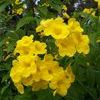
|
Esperanza, DwarfBotanical Name: Tecoma stans 'Nana'
Dwarf cultivar of the popular blooming perennial shrub native to Texas and Mexico. Bright green leaves are complimented with the multitude of yellow trumpet shape flowers appearing on the new growth from spring to fall. Esperanza is a tough and hardy plant ideal for any Texas landscape. It appreciates well-drained soils despite the quality it's grown in. Pruning is not necessary till the first frost when the entire plant is killed back to the ground; good mulching will allow the roots to survive and return in the spring with vigor. In north Texas, it is treated as an annual. Member of the Plants for Texas program. [ More Info ]
|
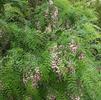
|
Eve's NecklaceBotanical Name: Styphnolobium affine
Eve’s Necklace is native to north-central Texas to the Edwards Plateau. It’s an ideal small tree for any landscape as it performs well as an understory or a small tree providing filtered shade to flower beds below. When grown in the shade, branches shoot upwards nearly vine line through other trees and shrubs in bid for sunlight. In full sun, it forms an irregular upright oval crown. It responds well to pruning, allowing the homeowner to guide the preferred shape. Towards the middle of spring, fragrant cascading rose-pink flowers will hang in clusters for two to three weeks. They are followed by black seed pods, up to six inches long, that dry and persist into the winter. The seed pods give the plant its name, as they look like black beads on a string. The pinnately compound leaves are slightly glossy green, but provide no fall color. The delicate foliage combined with the arching habit of the branches give the tree an overall fragile demeanor. Once established, Eve’s necklace is drought tolerant and exhibits no pest or disease issues. [ More Info ]
|

|
Evergold SedgeBotanical Name: Carex hachijoensis
Evergreen variegated clump forming grass that stays at an easily manageable size, while remaining maintenance and pest free once established in the landscape. Greenish flowers blend in with the leaves, Ideal for grassy borders or mass plantings. Grown from tissue culture as it does NOT reseed and become a pest. [ More Info ]
|
